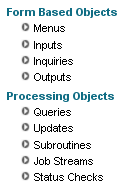Chapter 1-1: Overview of Application Design |
Objects or Processes The process definition component allows you to specify all types of objects or processes that, when integrated with the Data Dictionary and other application specifications, form the basic building blocks of an application. Options for objects or processes, shown in the figure below, are available from the Application Design Specifications Menu under the headings 'Form Based Objects' and 'Processing Objects'.
Objects or Processes Options Form Based Objects utilize the Image Editor to define or edit images and include the following process types: Menus, which provide a list of options available for selection by the user. Because an option on a menu may invoke another menu, an application can include many related menus. Inputs, which allow a user to enter, modify, view, and delete data. Inquiries, which allow a user quick access to viewing and optionally printing a specific record in a pre-defined format. Outputs, which allow a user to produce reports or lists in a specified format that can be viewed on a screen or printed on hard copy. Processing Objects do not involve designing images and include the following process types: Queries, which permit a user to select a subset of records from a file and sort the records. Updates, which allow data to be modified programmatically. Subroutines, by which the designer can develop 'stand-alone' procedural routines that can be invoked during the execution of any other type of process. Job Streams, which controls the execution of a series of related processes. Status Checks, which provides the capability to perform various kinds of error checking. Together they comprise the nine different types of objects or processes within APPX. You provide the structure for an application by connecting the various processes that you define. A preliminary discussion of APPX processes can be found in Understanding Process Design. |
Application Design Manual "Powered by Appx Software"12 ©2006 By APPX Software, Inc. All Rights Reserved |
